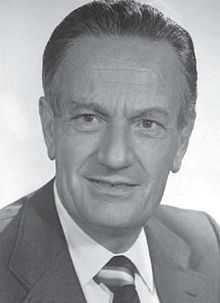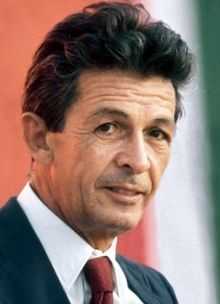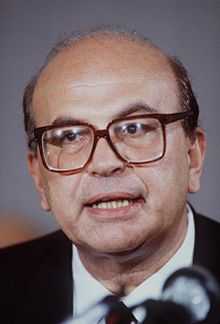Italian general election, 1979

|
|
|
|
|

|
| Legislative election results map. lightskyblue denotes provinces with a Christian Democratic plurality, Red denotes those with a Communist plurality, Gray denotes those with an Autonomist plurality. |
|
General elections were held in Italy on June 3, 1979.[1] This election was called just a week before the European vote: the lack of matching between the two elections caused much controversy for wasting public money.
Terroristic attacks by the Red Brigades caused a result which was quite opposite than three years before: for the first time the Italian Communist Party lost a lot of votes, delaying that government change that was seeming imminent in 1976, and the Communist defeat gave a new strength to all the minor parties, a concentration of vote on the Christian Democracy seeming less urgent to stop the red progress. However, the catholic party remained stable, while neo-fascist Italian Social Movement was weakened by its spin-off National Democracy.
Electoral system

Regional pluralities in Senate
The pure party-list proportional representation had traditionally become the electoral system for the Chamber of Deputies. Italian provinces were united in 32 constituencies, each electing a group of candidates. At constituency level, seats were divided between open lists using the largest remainder method with Imperiali quota. Remaining votes and seats were transferred at national level, where they was divided using the Hare quota, and automatically distributed to best losers into the local lists.
For the Senate, 237 single-seat constituencies were established, even if the assembly had risen to 315 members. The candidates needed a landslide victory of two thirds of votes to be elected, a goal which could be reached only by the German minorities in South Tirol. All remained votes and seats were grouped in party lists and regional constituencies, where a D'Hondt method was used: inside the lists, candidates with the best percentages were elected.
Parties and leaders
Results
Even this eighth legislature of the Italian Republic was a period of great instability. After the election, the Christian-Democratic leadership instructed moderate Francesco Cossiga to form a centrist minority government with the PSDI and the PLI, which accepted an official engagement into the government for the first time since 1973; however, when in 1980 Benigno Zaccagnini was fired as Secretary of the DC and socialist leader Bettino Craxi offered his help, Cossiga suddenly resigned and formed a new centre-left government with the PSI and the PRI, underling that the catholic leaders had no more problems to choose their allies from anywhere. However, Cossiga later fell on a budget project, and a traditional centre-left government led by Arnaldo Forlani was formed. The great scandal of the masonic lodge P2 sank Forlani in 1981.
This deep political crisis marked the birth of a new political formula which ruled Italy during the 80's: the Pentapartito (Pentaparty, or five parties), which was no more than the fusion of the two main alliances that DC had used to rule Italy since 1947, the centrism and the centre-left. This formula became possible because Bettino Craxi's Italian Socialist Party and Valerio Zanone's Italian Liberal Party accepted to form their first republican government together, moderating their positions and passing the opposition that had always divided them. But the Pentaparty pact had another important condition: the DC accepted to recognize a pair role with the other four parties, alternating into the government leadership. The Secretary of the Italian Republican Party, Giovanni Spadolini, so became the first non-DC Prime Minister of Italy since 1945. However, his little party was unable to stop the quarrels between their great allies, and after a little crisis during summer 1982, Spadolini resigned in autumn of the same year. Former-PM Amintore Fanfani formed a new government without the offended republicans, but the PSI, which had good surveys, imposed the final crisis in 1983 and a new general election.
Chamber of Deputies

Composition of the Chamber of Deputies after the election.
| Party |
Votes |
% |
Seats |
+/– |
|---|
|
Christian Democracy | 14,046,290 | 38.30 | 262 | –1 |
|
Italian Communist Party | 11,139,231 | 30.38 | 201 | –26 |
|
Italian Socialist Party | 3,596,802 | 9.81 | 62 | +5 |
|
Italian Social Movement | 1,930,639 | 5.26 | 30 | –5 |
|
Italian Democratic Socialist Party | 1,407,535 | 3.84 | 20 | +5 |
|
Radical Party | 1,264,870 | 3.45 | 18 | +14 |
|
Italian Republican Party | 1,110,209 | 3.03 | 16 | +2 |
|
Italian Liberal Party | 712,646 | 1.94 | 9 | +4 |
|
Proletarian Unity Party | 502,247 | 1.37 | 6 | – |
|
New United Left | 294,462 | 0.80 | 0 | New |
|
National Democracy | 229,205 | 0.63 | 0 | New |
|
South Tyrolean People's Party | 204,899 | 0.56 | 4 | +1 |
|
List for Trieste | 65,505 | 0.18 | 1 | New |
|
Friuli Movement | 35,254 | 0.10 | 0 | New |
|
Valdostan Union | 33,250 | 0.09 | 1 | +1 |
|
Others | 98,264 | 0.30 | 0 | – |
| Invalid/blank votes | 1,571,610 | – | – | – |
| Total | 38,242,918 | 100 | 630 | 0 |
| Registered voters/turnout | 42,203,354 | 90.62 | – | – |
| Source: Ministry of the Interior |
Senate of the Republic

Composition of the Senate after the election.
| Party |
Votes |
% |
Seats |
+/– |
|---|
|
Christian Democracy | 12,010,716 | 38.34 | 138 | +3 |
|
Italian Communist Party | 9,855,951 | 31.46 | 109 | –7 |
|
Italian Socialist Party | 3,252,410 | 10.38 | 32 | +3 |
|
Italian Social Movement | 1,780,950 | 5.68 | 13 | –2 |
|
Italian Democratic Socialist Party | 1,320,729 | 4.22 | 9 | +3 |
|
Italian Republican Party | 1,053,251 | 3.36 | 6 | – |
|
Italian Liberal Party | 691,718 | 2.21 | 2 | – |
|
Radical Party | 413,444 | 1.32 | 2 | +2 |
|
Radical Party–New United Left | 365,954 | 1.17 | 0 | New |
|
National Democracy | 176,966 | 0.56 | 0 | New |
|
South Tyrolean People's Party | 172,582 | 0.55 | 3 | +1 |
|
List for Trieste | 61,911 | 0.20 | 0 | New |
|
New United Left | 44,094 | 0.14 | 0 | New |
|
Valdostan Union | 37,082 | 0.12 | 1 | – |
|
Friuli Movement | 31,490 | 0.10 | 0 | New |
|
Others | 61,547 | 0.19 | 0 | – |
| Invalid/blank votes | 1,645,509 | – | – | – |
| Total | 32,976,304 | 100 | 315 | 0 |
| Registered voters/turnout | 36,362,037 | 90.69 | – | – |
| Source: Ministry of the Interior |
References
- ↑ Nohlen, D & Stöver, P (2010) Elections in Europe: A data handbook, p. 1048. ISBN 978-3-8329-5609-7
External links






